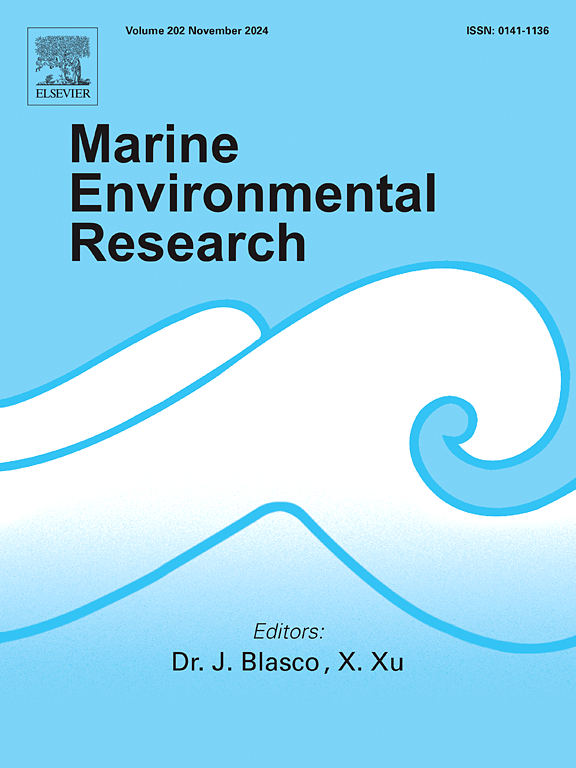微塑料积聚在地中海红海龟的所有主要器官中(Caretta Caretta)
IF 3
3区 环境科学与生态学
Q2 ENVIRONMENTAL SCIENCES
引用次数: 0
摘要
微塑料是一种普遍存在的海洋环境污染物,对海洋生态系统和各营养水平的生物构成严重威胁。海龟对塑料的摄入有很好的记录,红海龟(Caretta Caretta)已被确定为监测全球MP污染的指示物种。然而,我们对MPs在胃肠道外的易位和生物蓄积潜力的了解是有限的。在这里,我们证明了MP易位发生在这些海洋爬行动物中,并对10只搁浅的地中海红海龟的身体组织(包括肾脏、肝脏、脾脏、心脏、骨骼肌、皮下脂肪、胃、肠和生殖器官)中MP的积累进行了全面分析。在98.8%的样品中发现了外来微粒(约70%是MPs),并且在生殖器官中显著集中,其次是心脏。拉曼光谱显示聚丙烯、棉纤维和聚乙烯是最常见的微粒类型,光学光热红外(O-PTIR)光谱提供了嵌入红海龟心脏组织的棉质微纤维的直接可视化。未来的研究应确定MP在海龟器官中生物积累的生物学影响,以充分认识这些人为污染物对全球受保护和脆弱种群的影响。本文章由计算机程序翻译,如有差异,请以英文原文为准。

Microplastics accumulate in all major organs of the mediterranean loggerhead sea turtle (Caretta caretta)
Microplastics (MPs) are a pervasive marine environmental pollutant, posing a serious threat to marine ecosystems and organisms at all trophic levels. Plastic ingestion is well documented in marine turtles, and loggerhead sea turtles (Caretta caretta) have been identified as an indicator species to monitor MP pollution globally. Our understanding of the translocation and bioaccumulation potential of MPs beyond the gastrointestinal tract is, however, limited. Here we demonstrate that MP translocation occurs in these marine reptiles and present a comprehensive analysis of MP accumulation in body tissues of 10 stranded Mediterranean loggerhead turtles including the kidney, liver, spleen, heart, skeletal muscle, subcutaneous fat, stomach, intestine, and reproductive organs. Foreign microparticles were identified in 98.8 % of all samples (∼70 % being MPs) and were significantly concentrated in the reproductive organs followed by the heart. Raman spectroscopy revealed that polypropylene, cotton fibres, and polyethylene were the most common microparticle types, and optical photothermal infrared (O-PTIR) spectroscopy provided direct visualisation of cotton microfibres embedded in loggerhead heart tissue. Future studies should determine the biological impact of MP bioaccumulation in sea turtle organs, to fully appreciate the impacts of these anthropogenic pollutants on protected and vulnerable populations worldwide.
求助全文
通过发布文献求助,成功后即可免费获取论文全文。
去求助
来源期刊

Marine environmental research
环境科学-毒理学
CiteScore
5.90
自引率
3.00%
发文量
217
审稿时长
46 days
期刊介绍:
Marine Environmental Research publishes original research papers on chemical, physical, and biological interactions in the oceans and coastal waters. The journal serves as a forum for new information on biology, chemistry, and toxicology and syntheses that advance understanding of marine environmental processes.
Submission of multidisciplinary studies is encouraged. Studies that utilize experimental approaches to clarify the roles of anthropogenic and natural causes of changes in marine ecosystems are especially welcome, as are those studies that represent new developments of a theoretical or conceptual aspect of marine science. All papers published in this journal are reviewed by qualified peers prior to acceptance and publication. Examples of topics considered to be appropriate for the journal include, but are not limited to, the following:
– The extent, persistence, and consequences of change and the recovery from such change in natural marine systems
– The biochemical, physiological, and ecological consequences of contaminants to marine organisms and ecosystems
– The biogeochemistry of naturally occurring and anthropogenic substances
– Models that describe and predict the above processes
– Monitoring studies, to the extent that their results provide new information on functional processes
– Methodological papers describing improved quantitative techniques for the marine sciences.
 求助内容:
求助内容: 应助结果提醒方式:
应助结果提醒方式:


